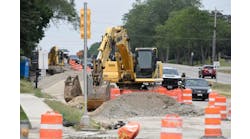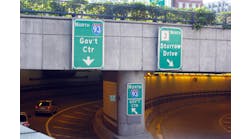To the average person driving over it, the 1-mile Portland Connector doesn’t seem like anything special—just a highway bypass along the Fore River, linking I-295 with the busy waterfront district of Maine’s largest city. To those who worked on it, though, the Connector represents something much bigger than a mile’s worth of roadway, three bridges and a reworked intersection. It is the prototype for a whole new breed of highway project in Maine.
In addition to a mile of roadway and three bridges connecting I-295 with the waterfront, the project also included a mile of multiuse pedestrian and biking trails built under the aegis of Portland Trails, a nonprofit organization dedicated to promoting multiuse trails in the greater Portland area. The Portland Connector trails form the backbone of the organization’s Fore River Trail. There also were numerous other stakeholders, including businesses and utilities with operations in the construction zone, whose needs and rights had to be taken into account.
Such a complex project in such a congested area required a fresh approach to highway construction. Fortunately, the Maine Legislature had recently approved the use of just such an approach for highway projects.
The Portland Connector is Maine’s first highway project to be undertaken using the design-build process, as opposed to the more traditional design-bid-build process. The state legislature approved design-build for use in highway projects after the success of the Sagadahoc Bridge between Woolwich and Bath, which was the state’s first design-build project of any kind.
Helping Veterans
The design-build approach allowed a bid team of four companies—Cianbro Corp., Shaw Brothers Construction, the Louis Berger Group and S.W. Cole Engineering—to work together as partners on the project from start to finish, coordinating their efforts, communicating with the community and tackling the project’s many challenges with all their combined resources. As general contractor, Cianbro managed the project.
“We all saw the benefits of having everybody in the same room and working through the issues,” said Shawn Smith, project manager for the Maine Department of Transportation. “Any issue was approached from all the angles.”
And there were plenty of issues to approach over the two-year span of the project. For instance: At the Connector’s west end, interfacing the new roadway with I-295 was fairly straightforward, but the east end of the bypass led to one of Portland’s busiest intersections, the rotary at the end of Veterans Memorial Bridge.
Veterans Circle was already known as a tough traffic spot. Dumping the 12,000 vehicles a day expected from the Connector into it would have made a bad situation worse, so the build team restructured the surface roads at the end of the bridge, removing the rotary entirely and replacing it with a three-signal at-grade intersection. Joe Lowry, a traffic engineer with the Louis Berger Group, described the one problem with that approach.
“There were very few alternative routes for [Veterans Circle],” he said, “so we had to accommodate the bulk of the existing traffic during the construction phase.”
They did it by developing a six-phase plan for rebuilding the intersection and managing the traffic within it as they did so. Using data on traffic volumes compiled as part of the initial environmental impact assessment for the project, Lowry and his team were able to test prospective traffic designs in a computer model before a single shovel went into the ground. The computer model could even extrapolate into the future, showing what traffic volumes at various key intersections in the region would be in 2025.
Once the design was ready and the six-phase implementation began, advanced signage, temporary detours and traffic signals, and a massive public communications effort eased what could have been a confusing and frustrating situation for the thousands of motorists who passed through the construction area every day. In the event, things went very well. In fact, the rumor began to circulate that traffic flowed better during construction than it had before the project began.
While he wouldn’t go that far, Lowry did express satisfaction with the way things turned out.
“I have no problem with saying that both construction personnel and the general public response indicated very few problems during construction,” he said.
The traffic engineering team’s work also involved coordinating with Portland Trails on the interactions between their Fore River Trail and the Connector. The traffic plan had to take into account three intersections and one roadway crossing with the trail, one of which had provisions for the use of existing signal equipment. In another spot, a roadway crossing with actuated signal equipment was installed specifically for trail users. The I-295 ramp at the Connector’s west end also has an actuated signal flasher to warn motorists of trail users crossing.
Meanwhile, the S.W. Cole team was dealing with a geotechnical challenge at the sites of Bridges 1 and 2. The bridges and their approach ramps were underlaid by up to 80 ft of soft marine clays, which made ground improvement vital to provide a good foundation and keep the bridges and ramps from subsiding later.
“What we did was a pretty conventional wick drain and preload program,” S.W. Cole Engineer Tim Boyce said.
After making preliminary investigations to determine how far the ground could be expected to settle under the load of the bridges, Shaw Brothers crews installed prefabricated vertical drains and built the embankments in stages, while S.W. Cole crews used instrumentation to monitor the drainage and settling process. Using the drains telescoped decades worth of ground compression into two years and ensured that the Portland Connector’s bridges and ramps will stay right where they belong.
Technology also played a role in the construction of the roadway earthworks. The Shaw Brothers crew used Global Positioning System (GPS) technology to make sure of both the alignment and the grade of the roadway. With GPS equipment they were able to locate drainage and curb sites and the roadway center line quickly and precisely.
“GPS is getting to be common throughout the country now,” Shaw said, noting that his company, Shaw Brothers Construction, had been using it for two years. “When we first started, we were right out in front with it.”
A Shaw Brothers crew also was working on a runway extension at nearby Portland International Jetport during the first year of the Connector project. Shaw said the two crews shared a GPS base station set up on a tower at the airport, further streamlining the process.
“It’s so much faster to use GPS,” he said. “We might not have gotten done in the same amount of time without it.”
The high-tech positioning system also made for more precise grading. Shaw explained that the grader on the Connector project was actually controlled by a computer getting its positioning information from GPS. The computer automatically adjusted the blade to produce the desired grade and provided the grader operator with a direction indicator.
“All we did was steer the machine,” he said.
The Connector project’s interaction with its environment extended beyond just roads and trails. A great deal of utility work had to be undertaken, especially in the vicinity of Veterans Circle. Gas, communications and electric power lines had to be reorganized and rerouted. In the process, Cianbro helped Central Maine Power (CMP) find a spot for a new electric substation, and subcontractor Utech Constructors spliced into a 115-KV transmission line to connect it to the grid. Even Amtrak got involved. Members of the design-build team met with railroad officials to discuss logistics and ensure that the project would not interfere with rail operations in the congested project area.
Just as important were the concerns and needs of the citizens and businesses in the area. Cianbro Project Manager Parker Hadlock cited the example of Barber Foods, a frozen foods company located in the construction zone. The design-build team met with representatives from Barber to work out scheduling details regarding the construction near their plant, making certain the work would not interfere with vital deliveries and even arranging backup parking for Barber employees during the job.
Public connector
Over all the facets and phases of the project there was a massive communications effort by Cianbro, the Maine DOT and the city of Portland designed to keep the public informed of developments—and keep the design-build team informed of public sentiments and concerns. The program included a website, www.portlandconnector.com, with constant updates on the project’s progress and channels for public comment, as well as public meetings, news releases, e-mailed motorist alerts and press relations.
“That was a huge part of our success,” Hadlock said. “Everything was coordination. It’s just getting everyone to pull on the rope in the same direction.”
Dottie Hutchins of HutchinsPR served as project public liaison for Cianbro.
“Foreseeing the benefits of getting everyone on the same page, the project’s management team strategically linked their stakeholder partnering process, led by Martin/Frankel Associates, with their public outreach efforts. It was a home run, or as Parker Hadlock once noted, we filled the bleachers and everyone helped us win the game,” she said.
The Portland Connector opened for traffic on Nov. 18, 2005—exactly on schedule. It alleviated congestion on the surface streets of the Portland peninsula and brought order to the chaos that was Veterans Circle. It left many of the stakeholders in the area better off than they were before the project (Barber Foods ended up with a bigger, better-designed parking lot; CMP got its new substation).
Perhaps most importantly, it proved that the design-build approach works for highway projects in Maine. All the members of the design-build team agree that the method streamlined the process, made the project more able to adapt to conditions in the field and take into account stakeholder needs and led to a higher-quality product overall.
Boyce described one of the advantages of the design-build process’s increased flexibility.
“The design-build on this project allowed some permitting that had previously been done to be massaged, allowing previously unmitigated wetland impacts,” he said. “I don’t think that would’ve been possible going design-bid-build.”
Shaw contrasted the smooth workings of the Portland Connector team with Boston’s Central Artery project, the infamous “Big Dig,” with its long history of contractor infighting and wasted time and money.
“There’s no fighting, there’s no finger-pointing,” Shaw said. “We all had our part to do. We’re all on the same team with a product to be delivered to the state of Maine, and we don’t get paid until all the parts come together.”
Lou Campbell, Cianbro project engineer and manager, agreed. “I think it turned out exceptionally well,” he said. “It took a tremendous effort and a great deal of partnering and teamwork by all parties, but [they] all showed a great willingness to make this project succeed.”
Moreover, those who worked on the Connector believe that the design-build approach saved the state a considerable amount of time and money.
“[Design-build] saved the state of Maine probably a year on the construction schedule,” Shaw said. “This was a big success for the taxpayers.”
Campbell believed the time savings might have been even greater. Shortly before the Connector’s opening in November 2005 he said, “We might be lucky if we were just getting to the actual bid process right now.”


